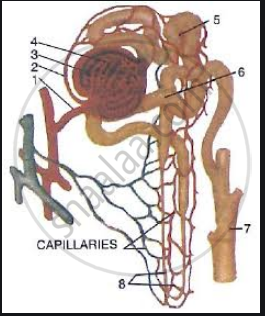Advertisements
Advertisements
प्रश्न
Match structures given in Column I with functions given in Column II.
| Column I | Column II | ||
| (i) | Stomata | (a) | Absorption of water |
| (ii) | Xylem | (b) | Transpiration |
| (iii) | Root hairs | (c) | Transport of food |
| (iv) | Phloem | (d) | Transport of water |
| (e) | Synthesis of carbohydrates |
उत्तर
| Column I | Column II | ||
| (i) | Stomata | (b) | Transpiration |
| (ii) | Xylem | (d) | Transport of water |
| (iii) | Root hairs | (a) | Absorption of water |
| (iv) | Phloem | (c) | Transport of food |
APPEARS IN
संबंधित प्रश्न
A dialysis machine contains long tubes coiled in a tank containing dialysing solution
Name the main waste which passes into the dialysing solution.
Fill in the blank.
.................. produces bile pigments from the heamoglobin of broken RBCs.
Answer the following in short.
Define transpiration in plants.
What is dialysis? Under what condition is it carried out?
Choose the odd one out in the following serie:
Column of Bertini, minora calyces, brain.
The following diagram represents a mammalian kidney tubule (nephron) and its blood supply.

Parts indicated by the guidelines 1to 8 are as follows:
1. Afferent arteriole from renal artery
2. Efferent arteriole
3. Bowman's capsule
4. Glomerulus
5. Proximal convoluted tubule with blood capillaries
6. Distal convoluted tubule with blood capillaries
7. Collecting tubule
8. U-shaped loop of Henle
Study the diagram and answer the question that follow:
Which structure (normally) contains the lowest concentration of glucose?
Complete the following sentence with appropriate word:
Besides excretion, the kidneys also carry out the important function of ______.
Write the functional activity of the following structure: Nephron
Answer the following question.
Birds are uricotelic in nature. Give reason.
The tadpole of frog lives in water, hence its mode of excretion is ______.
